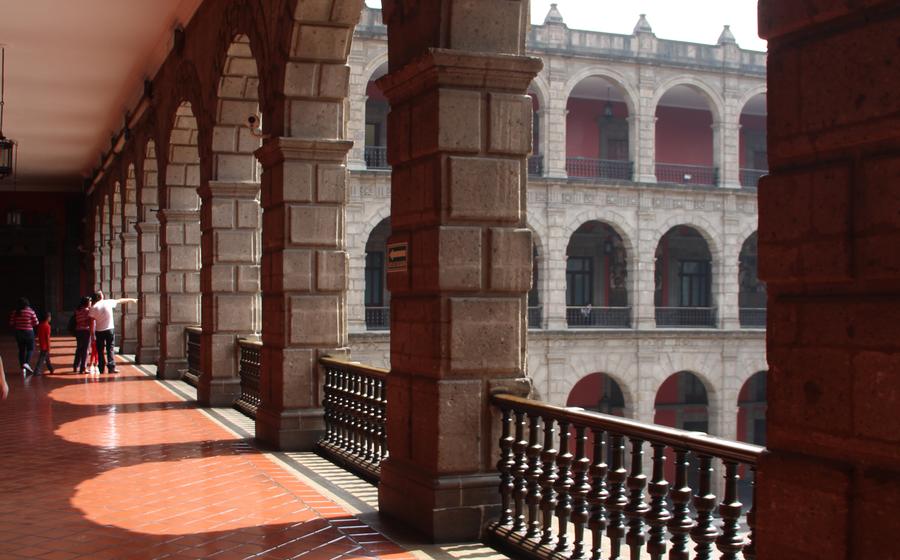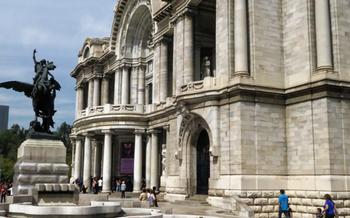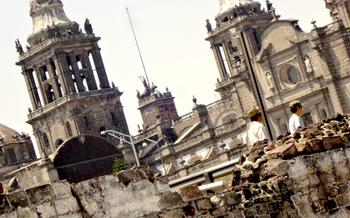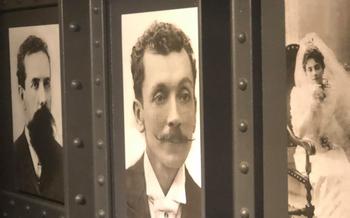
Secretaría de Educación Pública Murals
- The Secretaría de Educación Pública Murals: A Masterpiece of Mexican Symbolism and Themes
- The Building: A Symbol of Mexican Architecture
- Diego Rivera: The Mastermind Behind the Murals
- José Clemente Orozco: A Revolutionary Artist
- David Alfaro Siqueiros: A Pioneer of Muralism
- The Murals in Context: Mexican History and Culture
- Visiting the Murals: Practical Tips
- Beyond the Murals: Exploring the SEP Building
- Unveiling the Stories: Behind-the-Scenes Insights
- The Murals in Popular Culture: References and Adaptations
- The Murals as a Catalyst for Change: Social and Political Impact
- Off the Beaten Path: Hidden Gems in the SEP Building
- Interactive Experiences: Engaging with the Murals
- Insider Tip: An Unforgettable Visit
The Secretaría de Educación Pública Murals: A Masterpiece of Mexican Symbolism and Themes
The Secretaría de Educación Pública (SEP) Murals in Mexico and social struggles, offering a profound insight into the nation's identity.
The murals are a symphony of colors, symbols, and allegorical figures, each brushstroke imbued with deep meaning and symbolism. They explore themes of revolution, social justice, education, and the rich cultural heritage of Mexico. Rivera's "History of Mexico" depicts the country's journey from pre-Columbian times to the Mexican Revolution, while Orozco's "Catharsis" delves into the social and political struggles of the Mexican people. Siqueiros's "New Democracy" celebrates the ideals of democracy and social progress.
These murals are not merely works of art; they are powerful statements that reflect the aspirations, struggles, and triumphs of the Mexican people. They serve as a reminder of the nation's rich history and its commitment to social justice and progress.
The Building: A Symbol of Mexican Architecture
The Secretaría de Educación Pública Mexican architecture. It was designed by renowned Mexican architect José Villagrán García, who skillfully blended classical and modernist styles to create a striking and iconic structure. The building's façade is adorned with intricate carvings and sculptures, showcasing the rich artistic heritage of Mexico. The interior features spacious hallways, grand staircases, and a central courtyard, all adorned with decorative elements that reflect Mexican culture and history. The SEP building stands as a testament to the architectural prowess of Mexico, symbolizing the nation's pride and cultural identity.
Diego Rivera: The Mastermind Behind the Murals
Diego Rivera, a towering figure in Mexican art, played a pivotal role in the creation of the Secretaría de Educación Pública Murals. Born in 1886 in Guanajuato, Rivera's artistic journey began at a young age. He studied at the prestigious San Carlos Academy of Fine Arts in Mexico City, where he honed his skills and developed a deep appreciation for Mexican history and culture.
Rivera's artistic style was characterized by its vibrant colors, bold lines, and a profound connection to the social and political realities of his time. He incorporated elements of Mexican folklore, indigenous traditions, and revolutionary imagery into his works, creating a unique visual language that resonated with the Mexican people.
Rivera's political and social activism profoundly influenced his art. He was a staunch supporter of the Mexican Revolution and used his art as a tool to promote social justice and equality. His murals often depicted scenes of struggle, oppression, and the fight for a better future, reflecting his deep commitment to social change.
Rivera's legacy extends far beyond the Secretaría de Educación Pública Murals. He is considered one of the most influential artists of the 20th century, and his work has been exhibited in museums and galleries worldwide. His murals have become iconic symbols of Mexican art and culture, inspiring generations of artists and activists to use their creative expression to address social issues and promote change.
José Clemente Orozco: A Revolutionary Artist
José Clemente Orozco, alongside social justice and a commitment to revolutionizing Mexican art.
His artistic style was characterized by a raw and expressive approach, often employing distorted figures and intense colors to convey powerful emotions and narratives. Orozco's murals often depicted scenes of violence, suffering, and social inequality, reflecting his deep empathy for the marginalized and oppressed.
Orozco's political and social activism greatly influenced his artistic vision. He actively participated in the Mexican Revolution, and his murals often served as powerful tools for social commentary and propaganda. Through his art, he denounced injustice, celebrated the struggles of the working class, and advocated for a more equitable and just society.
Orozco's legacy extends far beyond his lifetime. His innovative techniques and bold artistic vision continue to inspire generations of artists and activists worldwide. His murals remain powerful symbols of social change and a testament to the transformative power of art in shaping society.
David Alfaro Siqueiros: A Pioneer of Muralism
David Alfaro Siqueiros, a revolutionary artist and one of the pioneers of the Mexican mural of artistic experimentation and political activism. His artistic career was marked by his unique style, characterized by dynamic compositions, bold colors, and experimental techniques.
Siqueiros' murals often tackled social and political issues, reflecting his deep commitment to revolutionary causes. He believed that art should be a powerful tool for social transformation and used his murals to convey messages of equality, justice, and liberation. His most famous mural at the SEP, "The Strike," depicts a powerful scene of workers rising up against oppression, symbolizing the struggle for labor rights and social justice.
Throughout his life, Siqueiros faced political persecution and exile due to his outspoken views and involvement in revolutionary movements. His unwavering commitment to social change earned him the title of "El Coronelazo" (The Colonel) and cemented his legacy as a trailblazing artist who fearlessly used his art to challenge the status quo and fight for a better world.
The Murals in Context: Mexican History and Culture
The Secretaría history and culture, deeply intertwined with the tumultuous events of the Mexican Revolution. This pivotal period, characterized by widespread social and political upheaval, saw the rise of muralism as a powerful means of artistic expression and social commentary. The murals, crafted by some of Mexico's most renowned artists, including Diego Rivera, José Clemente Orozco, and David Alfaro Siqueiros, served as a canvas to depict the struggles, aspirations, and triumphs of the Mexican people.
Through their vivid brushstrokes and symbolic imagery, these murals captured the essence of Mexican identity, delving into the country's indigenous heritage, colonial past, and the profound social transformations brought about by the Revolution. They celebrated the strength and resilience of the Mexican people, while also shedding light on the injustices and inequalities that plagued society. The murals served as a powerful reminder of the country's history, inspiring a sense of national pride and unity during a time of great turmoil.
Beyond their artistic significance, the SEP Murals played a crucial role in shaping Mexican culture and society. They became a symbol of the country's commitment to education and cultural expression, fostering a deep appreciation for the arts and their power to educate, inspire, and transform. The murals' enduring legacy continues to influence contemporary Mexican art and culture, serving as a source of inspiration and pride for generations to come.
Visiting the Murals: Practical Tips
To fully appreciate the Secretaría de Educación Pública Murals, it's essential to plan your visit wisely. The a breeze, as the building is well-connected by public transportation.
The murals are open to the public from Monday to Sunday, 9 am to 5 pm. Admission is free of charge, making it an accessible attraction for all. To delve deeper into the history and symbolism behind the murals, consider booking a guided tour. Knowledgeable guides will provide insightful commentary and anecdotes, enriching your experience.
If you prefer to explore at your own pace, self-guided tours are also an option. Informational brochures and maps are available at the entrance to assist you. Photography and videography are permitted, but using a tripod or flash is prohibited. Remember to be respectful and mindful of other visitors while capturing your memories.
Beyond the Murals: Exploring the SEP Building
The Secretaría de Educación architectural masterpiece in its own right. Its distinctive design, blending colonial and modern elements, has earned it a place among Mexico City's most iconic landmarks.
Notable architectural features include the grand entrance staircase, adorned with intricate wrought-iron railings and stained-glass windows. The building's central courtyard, surrounded by elegant arches and adorned with tropical plants, provides a serene oasis amid the bustling city.
Beyond the murals, the SEP Building boasts a collection of other notable works of art and cultural attractions. The building's lobby features a series of sculptures and paintings by renowned Mexican artists, offering a glimpse into the country's rich artistic heritage.
Guided tours of the SEP Building provide visitors with an in-depth exploration of its architectural and cultural significance. These tours often include access to restricted areas, such as the building's rooftop terrace, which offers panoramic views of the city.
Unveiling the Stories: Behind-the-Scenes Insights
The creation of the Secretariat of Public Education murals was not without its challenges. Diego Rivera, José Clemente Orozco, and David Alfaro Siqueiros faced numerous obstacles, both technical and political. Rivera, in particular, clashed with the government over the content of his murals, which often depicted controversial social and political themes. Despite these challenges, the artists persevered, driven by their passion for art and their commitment to creating a powerful and lasting legacy.
One of the most fascinating aspects of the murals is the hidden stories and anecdotes that surround their creation. For example, Rivera included portraits of his wife, Frida Kahlo, and his daughter, Guadalupe, in several of his murals. Orozco, on the other hand, often used symbolism and allegory to convey complex political messages. Siqueiros, a pioneer of experimental techniques, incorporated industrial materials such as cement and sand into his murals, creating a unique and textured effect.
The murals have also been the subject of controversy and debate over the years. Some critics have accused the artists of promoting communist propaganda, while others have praised them for their powerful social commentary. Despite these controversies, the murals have remained a source of pride and inspiration for Mexicans and art lovers worldwide.
Today, the murals undergo continuous restoration and preservation efforts to ensure their longevity. Conservators work tirelessly to repair damage caused by time, pollution, and natural disasters. Through these efforts, the murals continue to captivate and inspire generations of visitors, serving as a testament to the power of art to transcend time and make a lasting impact.
The Murals in Popular Culture: References and Adaptations
The Secretaría de Educación Pública Murals have extended their influence beyond the walls of the building, becoming a source of inspiration and reference in various forms of popular culture. Films, literature, and music have often drawn upon the murals' imagery, symbolism, and themes to create powerful artistic expressions. Notable examples include the film "Frida," which features scenes set in the SEP building and showcases the murals as a backdrop to Frida Kahlo's life and work. In literature, the murals have been referenced in works by prominent Mexican authors such as Carlos Fuentes and Octavio Paz, who have explored their cultural and historical significance. Additionally, the murals have inspired musical compositions, such as the "Murales de la Secretaría de Educación Pública" by Mexican composer Silvestre Revueltas, which evokes the spirit and grandeur of these iconic artworks.
The Murals as a Catalyst for Change: Social and Political Impact
The Secretaría de Educación Pública Murals were not merely artistic masterpieces but also powerful tools for social and political commentary. Rivera, Orozco, and Siqueiros used their art to challenge the status quo, provoke thought, and promote social justice. Their murals addressed issues such as poverty, inequality, worker's rights, and the Mexican Revolution.
The murals served as a platform for the artists to express their political views and advocate for change. Rivera, a staunch communist, infused his murals with socialist and Marxist imagery, while Orozco and Siqueiros were more critical of the government and depicted scenes of violence and oppression.
The murals sparked controversy and debate, but they also played a crucial role in raising awareness and mobilizing people to fight for their rights. They became symbols of resistance and hope, inspiring social movements and political activism.
To this day, the murals continue to be a source of inspiration and a reminder of the power of art to effect social change. They stand as a testament to the artists' commitment to using their talents to challenge injustice and promote a more equitable society.
Off the Beaten Path: Hidden Gems in the SEP Building
Beyond the renowned murals, the SEP building holds a treasure trove of hidden gems waiting to be discovered. Venture off the beaten path to uncover lesser-known murals and artworks that offer unique perspectives on Mexican history and culture. Explore secret corners, admire intricate details often overlooked, and marvel at architectural surprises. From hidden courtyards to rooftop terraces, the SEP building reveals its secrets to those willing to delve deeper. Don't miss the opportunity to uncover these hidden gems and gain a profound understanding of the building's rich artistic and historical tapestry.
Interactive Experiences: Engaging with the Murals
Beyond admiring the murals from a distance, visitors can immerse themselves in the artistic legacy of the SEP building through a range of interactive experiences. Virtual tours and online exhibitions allow art enthusiasts to explore the murals in detail, zoom in on specific sections, and learn about their symbolism and historical context from the comfort of their own homes. Interactive apps and multimedia presentations provide an engaging and educational way to discover the stories behind the murals, with augmented reality features that bring the artwork to life. Workshops and educational programs are also available for those who want to delve deeper into the techniques and themes of the murals. Engaging activities for families and children help bring the murals to life, making them a fun and educational experience for all ages.
Insider Tip: An Unforgettable Visit
To make the most of your visit to the Secretaría de Educación Pública Murals, plan your trip strategically. Aim to arrive early in the morning or late in the afternoon to avoid the crowds and bask in the tranquility of the surroundings. This will allow you to fully immerse yourself in the murals' intricate details and symbolism without distractions.
When it comes to capturing the essence of the murals through photography, remember to bring a wide-angle lens to capture the vastness of the compositions. A tripod will also come in handy to ensure steady shots. To truly understand the depth and significance of the murals, consider joining a guided tour led by an experienced art historian or mural expert. These tours offer invaluable insights into the symbolism, historical context, and artistic techniques employed by the muralists.
After exploring the murals, allocate some time to wander through the rest of the SEP building. Discover hidden architectural gems, such as the grand staircase, elegant courtyards, and intricate stained-glass windows. You might even stumble upon additional artworks and exhibitions that shed light on Mexican history and culture.
To enhance your visit, explore the surrounding area. Take a leisurely stroll through the historic center of Mexico City, a UNESCO World Heritage Site brimming with colonial architecture, vibrant markets, and traditional cuisine. Visit nearby attractions such as the Palacio Nacional, the Templo Mayor, and the Museo Nacional de Antropología to delve deeper into the rich tapestry of Mexican history and culture.
Remember to be respectful of local customs and etiquette during your visit. Dress modestly, avoid loud noises, and be mindful of the surrounding environment. By following these simple guidelines, you'll contribute to preserving the integrity of this cultural treasure for generations to come. Embrace the opportunity to engage with the locals, learn about their traditions, and immerse yourself in the vibrant spirit of Mexico.









